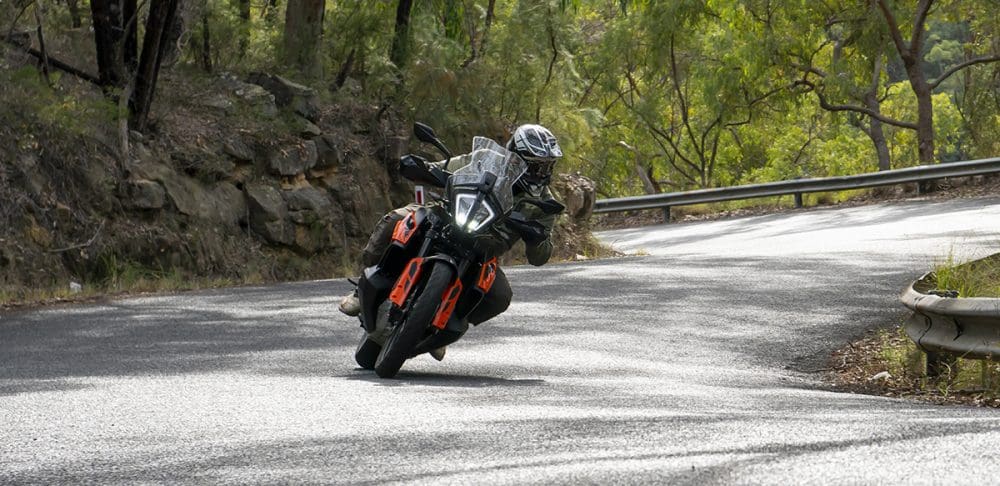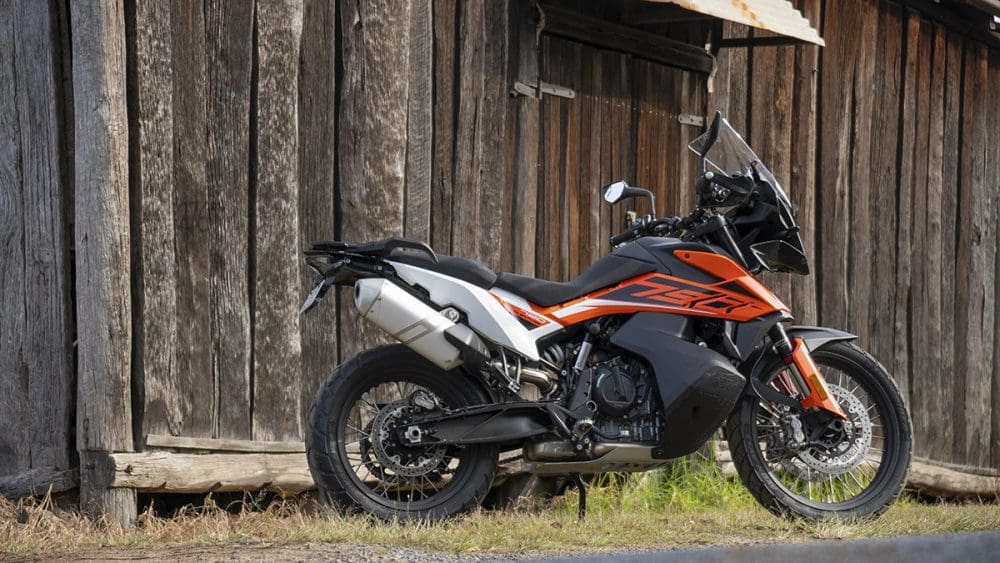If you hit the adventure forums online, you’ll find an abundance of die-hard fans who still consider the 950/990 Adventure the last of the truly rally-inspired, hardcore, adventure bikes that KTM made. That platform went all the way back to the turn of the century, to the Dakar-winning 950 of Fabrizio Meoni. They were angry, fast and relatively unrefined bikes with excellent off-road manners. They were oversized enduro bikes that could do road miles as well.
The problem with these multi-cylinder Adventure bikes is that they weighed 200-plus kilos and had towering seat heights of up to 915mm. This can be daunting even for taller and experienced riders. But for the less vertically enhanced, or for inexperienced riders, this combination often meant the difference between buying one of the marque’s bikes or not.
With the introduction of the 1190 Adventure in 2013 the authentic rally look changed; the weight crept up and seat heights remained, for some, dauntingly high. Sure, the horsepower increased, and rider aides were introduced, they became more refined. But back in the day, I never found myself wishing for more power from my 990, or for rider aides, for that matter. If anything, I’d have been happier to sacrifice a little power for a reduction in weight.
Somewhere in Austria, at least one kind person has been listening to my prayers (and probably those of others, since my conversational German is fairly limited).

So, we have KTM’s 790 Adventure. A smaller engine, a 799cc parallel-twin producing 70kW – still almost as much as the 950 Adventure, which came with barely six more. The news keeps getting better; the 790 weighs almost 30 kilos less than a 1290 Adventure S and has a seat height a whopping 60mm lower than the current 1090 Adventure R.
KTM claims the new twin is the most compact performance twin-cylinder on the market, and it is certainly more rev-happy than its V-twin relatives. It punches out a very respectable 88Nm of torque at 6600rpm, but it can feel a tad doughy at anything under 3500rpm if you’re lazy with gear changes. But keep the revs above 4000rpm and, coupled with the optional quickshifter, it’s a missile. KTM used two balancer shafts to reduce vibration, and it’s done an excellent job of smoothing things out. There’s very little vibration through the ’bar, and with the decent mirrors fitted you get a clear picture of what’s behind you. The quickshifter punches through a smooth six-speed gearbox that can be prone to the occasional false, and drama-finding, neutral.
The chrome-molybdenum-steel frame uses the engine as a stressed member with the rear section of the frame ceasing near the swingarm pivot, reducing size and weight. One upshot of this is that the footpeg hanger’s lower mounting bolt is screwed directly into the engine cases, which is an unusual design for a bike capable of tackling off-road terrain. The engine cases could be vulnerable to wallet frying levels of damage, so why make things worse? The compact frame geometry allowed KTM to use a long die-cast, open-lattice swingarm, which offers benefits in terms of traction and stability And so to the 790’s party trick that makes much of this possible; the low-slung 20-litre tanks helps to reduce the centre of gravity and also creates a slim and snag-free profile (important on narrow trails), all while allowing for a flatter and lower seat, which aids movement around the cockpit.
But it is not all good news. The reduced seat height (which is adjustable to either 850mm or 830mm with a simple yet effective, and tool-less system) does come at a cost. Firstly, it reduces ground clearance, although at 233mm it’s still adequate for most adventure riding. Secondly, it reduces the seat-to-footpeg distance to the extent that, even on the highest seat setting, for my over six-footer height, I found my legs a bit cramped.
For borderline geriatrics like myself, rider aids are kind of like mobile phones; you remember the old days before they invaded our pockets fondly, but now that you’re in the fold, you’re buggered if you know how you lived without them. The 790 comes standard with Power Assisted Slipper Clutch (PASC), lean-angle sensitive traction control and ABS, with Road, Rain and Off-road ride modes. All functions and information are displayed on a full-colour TFT dash and are controlled by buttons on the left-hand switchblock.
In Street mode, you get to play with the full 70kW on offer, and wheelie control, MTC and ABS are active. Flick into rain mode and the ECU reduces power and smooths out the throttle response and traction control kicks in earlier.

On the road, the 790 is predictable and a whole lot of fun through tight and twisty back roads with the Avon Trailrider tyres doing a good job of keeping things upright. The engine has plenty of power, as long as you keep it on the boil, and it doesn’t take kindly to labouring along at low rpm. Overtaking is a breeze, and if wheelies are your thing, you’ll get along with the 790 famously. The front fork seems a little harsh over road imperfections and there was a bit of noise from the dash/headlight area if you hit potholes at pace but handling always remained rock solid.
At highway speeds, the screen deflected air right at my helmet, causing irritating buffeting and noise (but I am nearly 190cm tall). The screen is adjustable, but it requires tools to move it, and on a bike that can correct a skidding wheel or connect to your phone via Bluetooth, you shouldn’t have to crack out the tools to do it.
To test the 790s off-road prowess, I headed for the fire trails that connect Kurrajong to Bilpin in Sydney’s Blue Mountains area. With some recent rain and a liberal dose of weekend four-wheel drivers, the trails were in a rough condition, with steep rutted-out descents, loose rocky inclines and the odd sandy section to spice things up. Once you’ve selected off-road mode, throttle response is smoothed out, the anti-wheelie feature is switched off and ABS is reduced at the front and deactivated on the rear wheel. The traction control dialled back in off-road mode, so that you can spin up the rear enough to suit most people’s rear-wheel steering needs. On steep pebble-littered hills, you can feel the traction control cutting in, but it doesn’t impede forward motion. You can deactivate the MTC, but in all but the muddiest conditions it worked flawlessly, so I don’t see the point.
Our 790 was fitted with the optional Quickershifter+ that allows for clutchless up and down gear changes. When you’re navigating rough dirt roads at speed it allows you to dispense with the clutch lever and keep all your fingers snuggly wrapped around the bars for maximum control. The 790 comes with MSR (Motor Slip Regulation), which limits engine braking by feeding in just enough throttle to reduce locking up the rear wheel. MSR is the kicker for downshifting through the gearbox on dirt. You can bang the shifter down a gear and the MSR system compensates fantastically. Even changing down while descending very steep, pockmarked hills, the MSR reduced rear skidding to barely discernible levels. The Quickshifter+ action is superb when you’re hard on the throttle, but if you’re just putting along, it can feel a bit clunky.
The 790 is slim through the knee area, so moving around on the bike is easy, whether seated or up on the pegs, and all that fuel sitting down so low makes for a very stable and balanced bike, aided by the steering damper keeping everything pointing in the right direction. There is an adjustable steering damper available from KTM’s parts catalogue, but it’s not required unless you plan to tackle off-road sections at the sort of speeds akin to Toby Price.
Although the fork seemed a bit harsh on road, once you hit the dirt, it’s superb. Both the fork and rear shock handled the many kilometres of corrugations without complaint and getting modest air from drainage humps presented no problems.
If you’re looking to do any meaningful off-road work, you’ll need to ditch the rubber inserts from the rider pegs. Once you’re standing on the pegs, you’re forced to bend your right leg at all sorts of awkward angles in order to operate the rear brake, as the insert raises your foot up too high to reach the pedal properly.
According to KTM, you’ll get 450km out of a tank of juice, but the seat is the limiting factor on the distance between stops. I could travel little more than an hour before I felt the need to stop and rest my rump. The seat is firm but thin, and after half an hour in the saddle, I could feel the plastic base digging into my fleshy bits. The pillion seat received a bad wrap from my son, who I dragged around on the back for a few hundred kilometres. He’s been on a lot of bikes in his relatively short life, so he’s well versed on the pillion gig. There’s a significant height difference between the rider seat and pillion seat, and the transition is acute. If I was seated up against the tank, he would slide into the gap created between me and the raised pillion seat. Remaining perched on the pillion seat made the gap between rider and pillion feel excessive. Obviously, if you have a bigger arse or pillion, this may not be a factor, but for us, it made for our combined seating positions being a weak point on the bike.
The other gripe I have is with the mudguard extender. It’s small and neat, but it’s useless at keeping road grime at bay. After my first ride on wet roads, I pulled up to find dirt-coloured GT stripe had been applied to the back of the bike, as well as up my back and helmet. So if you’re thinking of traversing a muddy road, take your son along as pillion…

TEST: PETE VORST PHOTOGRAPHY SAME MACLACHLAN











